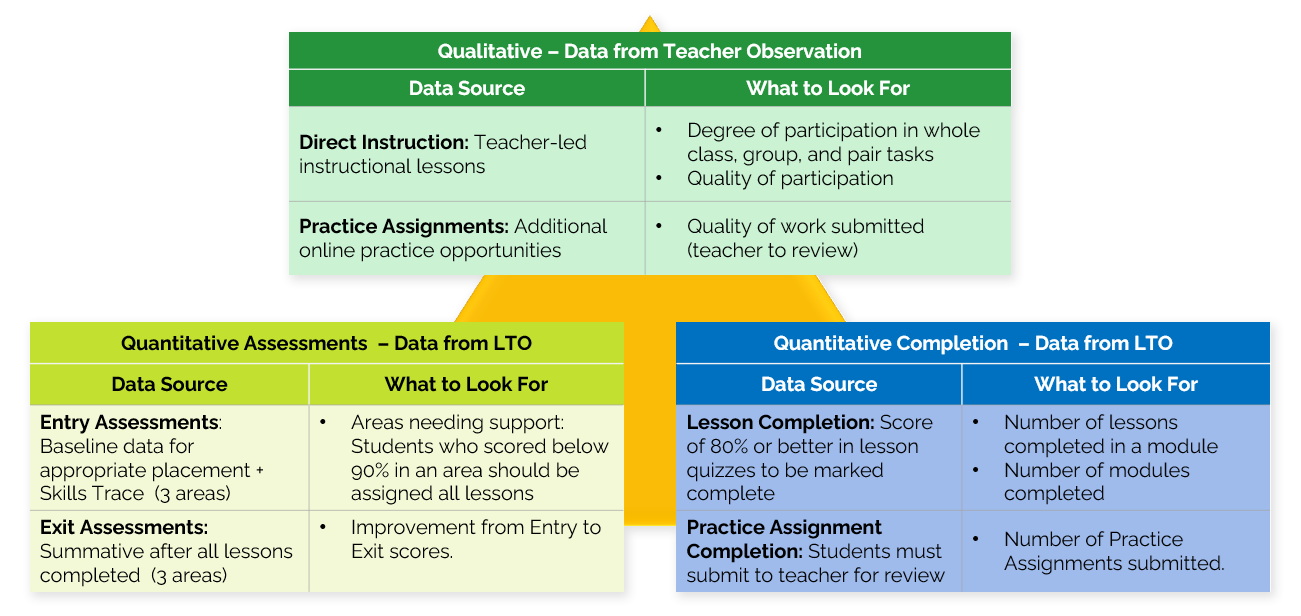Data Triangulation: A More Equitable Way to Assess Multilingual Learners
Many educators are rightly frustrated with the high importance placed on standardized assessments. Relying solely on quantitative data from a single snapshot in time to assess growth doesn’t seem fair. This also doesn’t give teachers a complete picture of what their English learner students know, nor the depth of their language capabilities.
A better, more holistic approach is to triangulate quantitative and qualitative data gathered throughout the school year around student performance. Triangulating data to assess learning outcomes allows teachers to draw more confident conclusions about student performance and progress.
With data triangulation, three main methods and multiple sources play a role in students' year-end assessments. Let’s go over these three “legs”, along with where and how to gather each type of data.
1
Direct Observation (Qualitative)
Data about students’ oral language and listening comprehension capabilities can be gathered through direct observation, both during whole-class and small-group instruction (SGI). Gauge how students perform when participating in class or collaborating linguistically with peers. Ask yourself: “What behaviors and language do I anticipate seeing and hearing during this activity?” Take subjective notes and anecdotal notes on what you observe. Informal 1-on-1 conversations with students can also give insight into a student’s productive and interpretive language skills
2
Assignment Completion (Quantitative and Qualitative)
The quantity and quality of submitted written assignments and completed group tasks should also factor into English learner progress. Remember that every assignment or in-class activity completed with effort brings new learnings – especially when errors are understood after explanation from the teacher. Track lesson completion relative to expectations and take notes on the quality of the work submitted.
3
Assessments and Tests (Quantitative)
The last piece is the formal evidence of student learning and information retention gathered from standardized assessments and graded tests. In this case, students study and prepare to “show what you what they know”. Review the absolute and relative scores for these assessments and tests. How did the student perform relative to expectations and relative to their peers?
Probably the most important aspect is whether there was a significant improvement (e.g., +10 percentage points) over time as shown by a summative assessment. Because English learners enter the classroom at different times throughout the year and come with diverse learning experiences, looking at an absolute score may not be a fair evaluation. However, a significant improvement over an initial low baseline score is something to acknowledge and celebrate.
What to Do with the Data
Now that you have gathered the data, you can normalize the data across the three "legs" if you need to provide each student with a single grade. For example, subjectively assign a score to the qualitative direct observation data (e.g., excellent individual/group participation is 100% or 10/10), so you can come up with a standardized score for all three legs.
Then weigh each score to determine a weighted average. How you weigh each of the three parts is up to you. You can assign equal weights to all three parts or more weight to one or two depending on your grading methodology. Ideally, you would share your expectations with students so they are aware of how they will be evaluated. Also, do not forget to provide students with qualitative feedback and examples based on your notes.
How Language Tree Online Can Help
The Language Tree Online hybrid curriculum incorporates multiple ways to track student progress and aid educators with assessing students. Included are formative and summative online assessments, teacher-led instructional routines, graded checks for understanding, and practice assignments:
Formative online Entry Assessments identify individual student learning opportunities and help guide whole class instruction.
Teacher-led instructional lessons, for whole-class or small-group use, provide multiple opportunities for productive language practice by students. This also allows teachers to assess students’ oral and listening capabilities. Lessons for newcomers include rubrics for evaluating student performance in the activities.
Built-in reporting includes Lesson and Practice Assignment tracking and monitoring. Teachers are also alerted when students may need intervention because they are having trouble completing the online checks for understanding.
Summative Exit Assessment results when compared with corresponding Entry Assessment results reveal growth in language skills as well as areas that still need focus.
Triangulating Data Using Language Tree Online Resources

Closing Thoughts
In the current educational climate, standardized summative assessment data heavily appear to outweigh other performance indicators, much to the disservice of English learners. Testing and “teaching to the test” have taken priority in classrooms due to pressure to improve student scores. While standardized assessments have value, they are still a single data point and may not fully reflect student growth across all four language domains. A student may also have test anxiety or simply be distracted to do his/her best on timed assessments.
What we are proposing with the data triangulation approach is for educators to take a more holistic picture of student growth and performance. We should advocate for our English learners with a balanced and authentic understanding of their strengths and challenges.